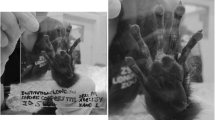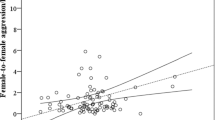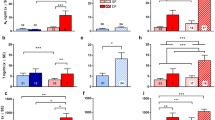Abstract
The challenge hypothesis posits a correlation between male androgen levels and mating system, male–male aggression in a sexual context, and parental effort. This model has received support across a variety of taxa, including primates. Most primate studies have focused on multi-male societies characterized by relatively high levels of male–male aggression and limited paternal care. To expand this dataset, predictions of the challenge hypothesis were tested in a population of wild siamangs (Symphalangus syndactylus), small apes characterized by intense territoriality, monogamous/polyandrous grouping patterns, and varying amounts of paternal behavior. Behavioral data were collected on 11 study groups (five two-male groups and six one-male groups). Seven hundred thirty-four fecal samples were collected from 18 adult males to quantify concentrations of fecal immunoreactive androgens (fiA) by radioimmunoassay. As predicted by the challenge hypothesis, males involved in the aggressive replacement of a resident male had significantly higher fiA concentrations than control males, while males displaying active parental care had significantly lower fiA concentrations than average. Results showed no association between male androgen concentration and group composition, male rank, or rate of intragroup male–male aggression. These latter findings, seemingly inconsistent with the hypothesis, could be explained by the clear and stable dominance relationships between co-resident males: given the very low rates of physical aggression, a low baseline testosterone is to be expected. Furthermore, the effects of increased intragroup conflict experienced by males in two-male groups might be offset by the higher frequency of intergroup aggression experienced by males in one-male groups.


Similar content being viewed by others
References
Alberts SC, Sapolsky RM, Altmann J (1992) Behavioral, endocrine and immunological correlates of immigration by an aggressive male into a natural primate group. Horm Behav 26:167–178
Altmann J (1974) Observational study of behavior: sampling methods. Behaviour 49:229–267
Archer J (2006) Testosterone and human aggression: an evaluation of the challenge hypothesis. Neurosci Biobehav R 30:319–345
Bales KL, French JA, McWilliams J, Lake RA, Dietz JM (2006) Effects of social status, age, and season on androgen and cortisol levels in wild male golden lion tamarins (Leontopithecus rosalia). Horm Behav 49:88–95
Barelli C, Heistermann M (2012) Sociodemographic correlates of fecal androgen levels in wild male white-handed gibbons (Hylobates lar). Int J Primatol 33:784–798
Bartoń K (2013) MuMIn: multi-model inference. R package version 1.9.13, http://cran.r-project.org/web/packages/MuMIn/index.html
Bates D, Maechler M, Bolker B, Walker S (2014) lme4: linear mixed-effects models using Eigen and S4. R package version 1.0-6, http://cran.r-project.org/package=lme4
Beehner JC, Bergman TJ, Cheney DL, Seyfarth RM, Whitten PL (2006) Testosterone predicts future dominance rank and mating activity among male chacma baboons. Behav Ecol Sociobiol 59:469–479
Beehner JC, Gesquiere L, Seyfarth RM, Cheney DL, Alberts SC, Altmann J (2009) Testosterone related to age and life-history stages in male baboons and geladas. Horm Behav 56:472–480
Beehner JC, Whitten PL (2004) Modifications of a field method for fecal steroid analysis in baboons. Physiol Behav 82:269–277
Bercovitch FB, Ziegler TE (2002) Current topics in primate socioendocrinology. Annu Rev Anthropol 31:45–67
Bercovitch FB (1993) Dominance rank and reproductive maturation in male rhesus macaques (Macaca mulatta). J Reprod Fertil 99:113–120
Borries C, Savini T, Koenig A (2011) Social monogamy and the threat of infanticide in larger mammals. Behav Ecol Sociobiol 65:685–693
Bouissou MF (1983) Androgens, aggressive behaviour and social relationships in higher mammals. Horm Res 18:43–61
Brockman DK, Whitten PL, Richard AF, Schneider A (1998) Reproduction in free-ranging Propithecus verreauxi: the hormonal correlates of mating and aggression. Am J Phys Anthropol 105:137–151
Cavigelli SA, Pereira ME (2000) Mating season aggression and fecal testosterone levels in male ring-tailed lemurs (Lemur catta). Horm Behav 37:246–255
Chivers DJ (1974) The siamang in Malaya: a field study of a primate in a tropical rain forest. In: Kuhn H, Luckett WP, Noback CR, Schultz AH, Starck D, Szalay FS (eds) Contributions to primatology. S. Karger, Basel, pp 1–335
Clark MM, Galef BG (1999) A testosterone-mediated trade-off between parental and sexual effort in male mongolian gerbils (Meriones unguiculatus). J Comp Psychol 113:388–395
Crockford C, Wittig RM, Whitten PL, Seyfarth RM, Cheney DL (2008) Social stressors and coping mechanisms in wild female baboons (Papio hamadryas ursinus). Horm Behav 53:254–265
Czekala NM, Lance VA, Sutherland-Smith M (1994) Diurnal urinary corticoid excretion in the human and gorilla. Am J Primatol 34:29–34
Dean RB, Dixon WJ (1951) Simplified statistics for small numbers of observations. Anal Chem 23:636–638
Delignette-Muller ML, Pouillot R, Denis J-, Dutang C (2014) fitdistrplus: help to fit of a parametric distribution to non-censored or censored data, http://cran.r-project.org/web/packages/fitdistrplus/index.html
Dixson AF, George L (1982) Prolactin and parental behaviour in a male new world primate. Nature 299:551–553
Fox J, Weisberg S (2011) An R companion to applied regression. Sage, Thousand Oaks
Gaetano TJ (2012) Hormonal and morphological aspects of growth and sexual maturation in wild-caught male vervet monkeys (Chlorocebus aethiops pygerythrus). Ph.D. thesis, University of Wisconsin, Milwaukee
Gesquiere LR, Learn NH, Simao MCM, Onyango PO, Alberts SC, Altmann J (2011) Life at the top: rank and stress in wild male baboons. Science 333:357–360
Girard-Buttoz C, Heistermann M, Krummel S, Engelhardt A (2009) Seasonal and social influences on fecal androgen and glucocorticoid excretion in wild male long-tailed macaques (Macaca fascicularis). Physiol Behav 98:168–175
Gittins SP, Raemaekers JJ (1980) Siamang, lar, and agile gibbons. In: Chivers DJ (ed) Malayan forest primates: ten year’s study in tropical rain forest. Plenum, New York, pp 63–105
Goymann W, East ML, Hofer H (2003) Defense of females, but not social status, predicts plasma androgen levels in male spotted hyenas. Physiol Biochem Zool 76:586–593
Gray PB, Kahlenberg SM, Barrett ES, Lipson SF, Ellison PT (2002) Marriage and fatherhood are associated with lower testosterone in males. Evol Hum Behav 23:193–201
Harding CF (1981) Social modulation of circulating hormone levels in the male. Am Zool 21:223–231
Hart BL (1974) Gonadal androgen and sociosexual behavior of male mammals: a comparative analysis. Psychol Bull 81:383–400
Higley JD, Mehlman PT, Poland RE, Taub DM, Vickers J, Suomi SJ, Linnoila M (1996) CSF testosterone and 5-HIAA correlate with different types of aggressive behaviors. Biol Psychiat 40:1067–1082
Hirschenhauser K, Oliveira RF (2006) Social modulation of androgens in male vertebrates: meta-analyses of the challenge hypothesis. Anim Behav 71:265–277
Huck M, Löttker P, Heymann EW, Heistermann M (2005) Characterization and social correlates of fecal testosterone and cortisol excretion in wild male Saguinus mystax. Int J Primatol 26:159–179
Klinkova E, Heistermann M, Keith Hodges J (2004) Social parameters and urinary testosterone level in male chimpanzees (Pan troglodytes). Horm Behav 46:474–481
Klukowski M, Nelson CE (1998) The challenge hypothesis and seasonal changes in aggression and steroids in male northern fence lizards (Sceloporus undulatus hyacinthinus). Horm Behav 33:197–204
Kraus C, Heistermann M, Kappeler PM (1999) Physiological suppression of sexual function of subordinate males: a subtle form of intrasexual competition among male sifakas (Propithecus verreauxi)? Physiol Behav 66:855–861
Lappan S (2005) Biparental care and male reproductive strategies in siamangs (Symphalangus syndactylus) in southern Sumatra. Ph.D. thesis, New York University
Lappan S (2007) Patterns of dispersal in Sumatran siamangs (Symphalangus syndactylus): preliminary mtDNA evidence suggests more frequent male than female dispersal to adjacent groups. Am J Primatol 69:1–7
Lappan S (2008) Male care of infants in a siamang (Symphalangus syndactylus) population including socially monogamous and polyandrous groups. Behav Ecol Sociobiol 62:1307–1317
Lynch JW, Ziegler TE, Strier KB (2002) Individual and seasonal variation in fecal testosterone and cortisol levels of wild male tufted capuchin monkeys, Cebus apella nigritus. Horm Behav 41:275–287
Marshall AJ, Hohmann G (2005) Urinary testosterone levels of wild male bonobos (Pan paniscus) in the Lomako Forest, Democratic Republic of Congo. Am J Primatol 65:87–92
McGlothlin JW, Jawor JM, Ketterson ED (2007) Natural variation in a testosterone-mediated trade-off between mating effort and parental effort. Am Nat 170:864–875
Morino L (2012) Behavioral endocrinology of wild male siamangs (Symphalangus syndactylus). Ph.D. thesis, Rutgers University
Morino L (2014) Dominance relationships among siamang males living in multimale groups. Am J Primatol (in press)
Muehlenbein MP, Watts DP, Whitten PL (2004) Dominance rank and fecal testosterone levels in adult male chimpanzees (Pan troglodytes schweinfurthii) at Ngogo, Kibale National Park, Uganda. Am J Primatol 64:71–82
Muller MN, Wrangham RW (2004) Dominance, aggression and testosterone in wild chimpanzees: a test of the ‘challenge hypothesis’. Anim Behav 67:113–123
Muroyama Y, Shimizu K, Sugiura H (2007) Seasonal variation in fecal testosterone levels in free-ranging male Japanese macaques. Am J Primatol 69:603–610
Nunes S, Fite JE, French JA (2000) Variation in steroid hormones associated with infant care behaviour and experience in male marmosets (Callithrix kuhlii). Anim Behav 60:857–865
O’Brien TG, Kinnaird MF, Nurcahyo A, Prasetyaningrum M, Iqbal M (2003) Fire, demography and the persistence of siamang (Symphalangus syndactylus: Hylobatidae) in a Sumatran rainforest. Anim Conserv 6:115–121
Oliveira RF, Hirschenhauser K, Carneiro LA, Canario AVM (2002) Social modulation of androgen levels in male teleost fish. Comp Biochem Physiol B 132:203–215
Ostner J, Kappeler PM, Heistermann M (2002) Seasonal variation and social correlates of androgen excretion in male redfronted lemurs (Eulemur fulvus rufus). Behav Ecol Sociobiol 52:485–495
Ostner J, Kappeler P, Heistermann M (2008) Androgen and glucocorticoid levels reflect seasonally occurring social challenges in male redfronted lemurs (Eulemur fulvus rufus). Behav Ecol Sociobiol 62:627–638
Palombit RA (1994a) Dynamic pair bonds in hylobatids: implications regarding monogamous social systems. Behaviour 128:65–101
Palombit RA (1994b) Extra-pair copulations in a monogamous ape. Anim Behav 47:721–723
Palombit RA (1996) Pair bonds in monogamous apes: a comparison of the siamang (Hylobates syndactylus) and the white-handed gibbon (Hylobates lar). Behaviour 133:321–356
R Core Team (2013) R: a language and environment for statistical computing, http://www.R-project.org
Rangel-Negrín A, Dias PAD, Chavira R, Canales-Espinosa D (2011) Social modulation of testosterone levels in male black howlers (Alouatta pigra). Horm Behav 59:149–166
Reburn CJ, Wynne-Edwards KE (1999) Hormonal changes in males of a naturally biparental and uniparental mammal. Horm Behav 35:163–176
Rose RM, Holaday JW, Bernstein IS (1971) Plasma testosterone, dominance rank and aggressive behaviour in male rhesus monkeys. Nature 231:366–368
Ross CN, French JA, Patera KJ (2004) Intensity of aggressive interactions modulates testosterone in male marmosets. Physiol Behav 83:437–445
Sapolsky RM (1982) The endocrine stress-response and social status in the wild baboon. Horm Behav 16:279–292
Sapolsky RM (1983) Endocrine aspects of social instability in the olive baboon (Papio anubis). Am J Primatol 5:365–379
Sapolsky RM (1993) The physiology of dominance in stable versus unstable social hierarchies. In: Mason WA, Mendoza SP (eds) Primate Social Conflict. State University of New York Press, Albany, pp 171–204
Setchell JM, Smith T, Wickings EJ, Knapp LA (2008) Social correlates of testosterone and ornamentation in male mandrills. Horm Behav 54:365–372
Shur MD, Palombit RA, Whitten PL (2008) Association between male testosterone and friendship formation with lactating females in wild olive baboons (Papio hamadryas anubis). Am J Phys Anthropol:193
Storey AE, Walsh CJ, Quinton RL, Wynne-Edwards KE (2000) Hormonal correlates of paternal responsiveness in new and expectant fathers. Evol Hum Behav 21:79–95
Teichroeb JA, Sicotte P (2008) Social correlates of fecal testosterone in male ursine colobus monkeys (Colobus vellerosus): the effect of male reproductive competition in aseasonal breeders. Horm Behav 54:417–423
Trainor BC, Marler CA (2001) Testosterone, paternal behavior, and aggression in the monogamous California mouse (Peromyscus californicus). Horm Behav 40:32–42
van Anders SM, Tolman RM, Volling BL (2012) Baby cries and nurturance affect testosterone in men. Horm Behav 61:31–36
van Belle S, Estrada A, Ziegler TE, Strier KB (2009) Social and hormonal mechanisms underlying male reproductive strategies in black howler monkeys (Alouatta pigra). Horm Behav 71:153–164
Whitten PL, Turner TR (2004) Male residence and the patterning of serum testosterone in vervet monkeys (Cercopithecus aethiops). Behav Ecol Sociobiol 56:565–578
Whitten PL, Brockman DK, Stavisky RC (1998) Recent advances in noninvasive techniques to monitor hormone-behavior interactions. Yrbk Phys Anthropol 41:1–23
Wickings EJ, Dixson AF (1992) Testicular function, secondary sexual development, and social status in male mandrills (Mandrillus sphinx). Physiol Behav 52:909–916
Wingfield JC, Hegner RE, Dufty AM Jr, Ball GF (1990) The “challenge hypothesis”: theoretical implications for patterns of testosterone secretion, mating systems, and breeding strategies. Am Nat 136:829–846
Zeileis A, Hothorn T (2002) Diagnostic checking in regression relationships. R News 2:7–10
Ziegler TE, Wittwer DJ (2005) Fecal steroid research in the field and laboratory: improved methods for storage, transport, processing, and analysis. Am J Primatol 67:159–174
Ziegler TE, Snowdon CT (2000) Preparental hormone levels and parenting experience in male cotton-top tamarins, Saguinus oedipus. Horm Behav 38:159–167
Acknowledgments
I am grateful to Laji, Tarmin, Usman, Maryadi, Mislan, Budi, and Opo for their commitment, skill, and positive attitude in the forest; to my parents, Ignacia Perugorria, Jacqueline Hicks, Alice Elder, Flor Gragera de Leon, and Susana Galan for their support at different stages of this project; to Marc Shur for inspiring conversations; to Ryne Palombit, Susan Lappan, Jacinta Beehner, and Carola Borries for professional, wise, and supportive advising; to Guang Dong, Erin Vogel, and Andrew MacIntosh for statistical advice; to Susana Galan for her patience and perception; to Larry Katz and Susan Becker (Animal Sciences Lab, Rutgers University) for introducing me to the beauty and rigor of labwork; and to three anonymous reviewers for their meticulous and constructive comments. I gratefully acknowledge the National Science Foundation (Grant ID 0726022) and Wenner-Gren Foundation (Grant 7766) for funding my research project and the State Ministry of Research and Technology and Forestry Department of Indonesia for permission to conduct research in Sumatra.
Ethical standards
The collection of behavioral and hormonal data complied with current laws of Indonesia and Rutgers University.
Conflict of interest
I have no financial relationship with the foundations/organizations that sponsored my research.
Author information
Authors and Affiliations
Corresponding author
Additional information
Communicated by D. P. Watts
Rights and permissions
About this article
Cite this article
Morino, L. Social correlates of androgen levels in a facultatively monogamous ape (Symphalangus syndactylus): a test of the challenge hypothesis. Behav Ecol Sociobiol 69, 243–251 (2015). https://doi.org/10.1007/s00265-014-1837-1
Received:
Revised:
Accepted:
Published:
Issue Date:
DOI: https://doi.org/10.1007/s00265-014-1837-1




